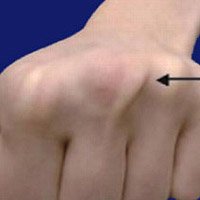The boxer’s knuckle refers to an injury to the extensor mechanism of the fingers (the musculo-tendinous unit that allows the finger to extend) and is one of the more serious musculoskeletal injuries in boxing. During a punch, the metacarpophalangeal joint (the joint of the knuckle) is rapidly forced into flexion, stretching the surrounding soft tissue to its maximum tolerance. Over time this may result in a chronic breakdown in the surrounding tissue, although injury to this area may also occur acutely. A structure called the sagittal band crosses over the top of the tendon, and this may be damaged in an injury or chronic overuse involving the end of the finger gliding back upon the metacarpal. The likelihood of this central tendon rupturing completely is increased when the mechanism of injury includes an extreme ulnar deviation (moving towards the side of the little finger).
These injuries will often present with a deformity around the knuckle, with the tendon “flopping to the side. Milder presentations of these injuries can often be managed conservatively in fighters, using relative rest to allow the area to settle, followed by graded return to punching, initially on softer surfaces (water bags/thicker gloves). Local manual therapy around the knuckle may be useful in decreasing the sensitivity, and if there is associated joint stiffness, joint mobilisations may also be beneficial.
The more severe variation of this injury is when the central tendon splits down the middle. The most definitive treatment for this injury is a surgical procedure called a sagittal band repair. This procedure involves reconstructing the soft tissue that holds the tendon in place, therefore restoring the stability of the musculotendinous complex. The likely return to competition following this procedure is in the realm of 5 months (1). The long-term outcome following this procedure, however, is excellent. The surgeon must understand the demands of the athlete and ensure that the incision is off to the side of the knuckle to prevent any scarring occurring over the site of direct impact in punching.
